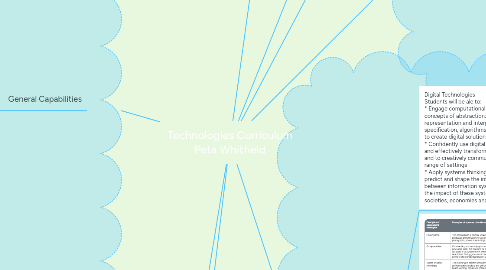Technologies Curriculum Peta Whitfield
by Peta Whitfield


1. Design Technologies
1.1. Knowledge, understanding and skills associated with the initial design, development and use of technologies. Students involve their understandings of ethical, legal and aesthetical factors to influence decision making.
1.2. C H A N G E Students consider the economic, environmental and social impacts technologies have and how these can instead be manipulated to promote a positive environmental changes and a sustainable future.
2. General Capabilities
2.1. Literacy Building knowledge and skills to communicate, listen, write, speak, and create texts (digital, written, oral and print). Students develop literacy as they communicate contexts, read and interpret instructions in written, visual and coded forms to operate and manipulate different technologies.
2.2. Numeracy Technologies and numeracy play hand in hand with each other. Numeracy is found in technologies through the use of data analysis and statistics; measure, record and calculate throughout the planning and implementation of digital projects, as well as manipulating and/or interacting with 3D models and graphical software to create technical drawings and digital models.
2.3. ICT ICT is incorporated into technologies individually within each strand. ICT in Digital Technologies: Students learn to integrate and understand the properties of data, digital thinking, audiences, procedures and computational thinking. ICT in Design Technologies: ICT skills are extended on and developed through investigation, analysis, evaluation and the communication of design concepts.
2.4. Creative and Critical Thinking Using imagination, creativity to generate and then evaluate their own ideas and concepts.
2.5. Personal and Social Capability Students learn to develop and extend of their skills of recognising and responding to empathy, forming positive relationships and making responsible decisions. Design and innovation involves risk-taking and students will learn to evaluate and assess these risks and make informed decisions, as well as enhancing their social awareness and development.
2.6. Ethical Understanding Students learn the ethical procedures for working with groups and individuals of people and animals as well as contextual data. Students learn how to detect and respond to bias and inaccuracies.
2.7. Intercultural Understanding Students lookout a variety of communities and how they use technologies and how these impact their way of life, practices, and interactions on local, national and global scales.
3. Cross-Curriculum Priorities
3.1. Aboriginal Torres-Strait Islander Histories and Cultures. Students explore how Aboriginal and Torres Strait Islander Peoples' capacity for innovation is evident through a range of traditional, contemporary and emerging technologies and practices. These technologies and practices are used to purposely build and maintain cultural community and economic practices.
3.2. Australia's Engagement with Asia Technologies are the priority of Asia's relationship to Australia. Students learn to recognise the significance and interaction between human activity and the varied environments of Asia continues to fuel the need for create solutions and collaborations.
3.3. Sustainability Technologies focus on developing the skills, knowledge and understanding required to develop and embed successful sustainable solutions
4. Design Technologies ABLEWA Students are exposed to technologies and their purposes and how they meet everyday needs. Technologies in this category are: Engineering principles and systems Food and fibre production Food specialisations Materials and technologies specialisations STAGE A: Students learn their characteristics and how each technology meets their individual needs, as well as societal needs. STAGE B: Students explore technologies and how they meet their own personal and social needs. STAGE C: Students explore and investigate technologies including their purposes and how they meet needs. STAGE D: Students explore technologies and how they meet needs in local settings.
5. Digital Technologies
5.1. E M P O W E R Digital technologies empower students to actively collaborate and communicate across multiple avenues using a variety of devices shaping change and innovative growth.
6. Student Diversity
6.1. Students with Disability All students are entitled to receive an education of equal valued content. Teachers can source appropriate content for students according to their individual capabilities from across the K-10 Curriculum. Teacher will need to consider and include any necassary adjustments to the delivery of their lessons to ensure all students are given equal opportunity to learn.
6.2. English as an additional language Consideration is to be given to students who possess the english language as an additional language or dialect. Students may take more time to process and develop understanding of content, to which the teacher must accommodate for and offer additional support where required.
6.3. Gifted and Talented Students Teachers can offer students a more enriched educational experience by giving them more in-depth content (linking more content descriptors) and emphasising more singular aspects of the content descriptors.
7. Aims and Objectives
7.1. Digital Technologies Students will be ale to: * Engage computational thinking and the key concepts of abstraction; data collection, representation and interpretation; specification, algorithms and implementation to create digital solutions * Confidently use digital systems to efficiently and effectively transform data into information and to creatively communicate ideas in a range of settings * Apply systems thinking to monitor, analyse, predict and shape the interactions within and between information systems and understand the impact of these systems on individuals, societies, economies and environments.
7.2. ASSESSMENTS
7.2.1. ASSESSMENTS Cont..
